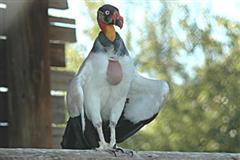Vulture - king
American king vulture Scientific Name: Sarcoramphus papa
Thu, 10th July, 2025 - 1:15 am GMT
Sponsor Ads:

Alternative Name
American king vulture Scientific Name: Sarcoramphus papaBasic Info
Without a doubt, the King Vulture is the most colorful bird in the vulture group. Its basic color is creamy, with its wings and tail being black, and its legs and feet gray. It has no feathers on its head or face to keep the blood of their prey from getting in them, but its skin is a yellowy rose and orange, with black and gray markings. Its wattle is bright orange and red. Its eyes are a pale yellowy color. The short blunt claws of the King Vulture are used in perching or walking, not in seizing prey, as in other raptors. Their tongues are rough like a cat's and are used in pulling meat off bones. One of the largest vultures, its wingspan measures four feet and it stands 30 inches tall.
Health
The King Vulture is rarely kept in captivity, and is generally only seen in zoos or in captive breeding programs. This should not be a surprise since this species is both endangered and difficult to keep. It has been reported that the King vulture is particularly sensitive to frostbite, and precautions should be taken to prevent exposure to cold for this reason. The King Vulture is particularly sensitive to frostbite on its toes, if any toes are lost due to frostbite there is a high probability that this glorious raptor will have to be euthanised. Breeding Male and female King Vultures are identical and can only be sexed via DNA analysis or surgery. These raptors become sexually mature between the ages of four and five years. They prefer nests on the ground, such as niches under rocky overhangs, fallen logs, and stumps. They do not usually build a nest, but use what is already there with little rearrangement. One or two eggs are laid at a time, and both parents share the incubation of them. The eggs hatch between four and six weeks after they are laid, and the chicks are a brown color. The chick will leave the nest after about a year and will get its adult plumage at around 18 months.Habitat
N/ABehavior
N/AOrigin
North AmericaHistory
King Vultures have been known in early American civilizations in a variety of manners. Mayas included them in their hieroglyphic writing system with their symbol meaning 'king'. Rural South Americans thought that if their shadows touched you a misfortune would occur, and Native Americans used their blood and feathers to ward off disease.Common Foods
N/ASponsor Ads:
"Great spirits have always found violent opposition from mediocrities. The latter cannot understand it when a man does not thoughtlessly submit to hereditary prejudices but honestly and courageously uses his intelligence." -- Albert Einstein
Vulture - king
Coded by: BGID® | ALL RIGHTS RESERVED Copyright © 2000-2025
Disclaimer | Privacy | Report Errors / Contact | Credits

 Why haven't we as a collective earth met with aliens yet?
Why haven't we as a collective earth met with aliens yet?  World EcoSystem - Biodiversity Changes - Who is on board and who isn
World EcoSystem - Biodiversity Changes - Who is on board and who isn  Homosexual behavior stems from the mind or genetics?
Homosexual behavior stems from the mind or genetics?  The Best Text Adventure You Will Ever Play! The official site:
The Best Text Adventure You Will Ever Play! The official site:  Mouthwash - Mouthrinse - Mouth Sores - Healing Infections - Gingivitis
Mouthwash - Mouthrinse - Mouth Sores - Healing Infections - Gingivitis  Treatment for Depression
Treatment for Depression  Ultra radical and violent Islamist group that even rivals Al Qaeda
Ultra radical and violent Islamist group that even rivals Al Qaeda  An idea to have teachers who want to carry guns to school undergo some level of police training will be left up to local school districts and police departments.
An idea to have teachers who want to carry guns to school undergo some level of police training will be left up to local school districts and police departments.